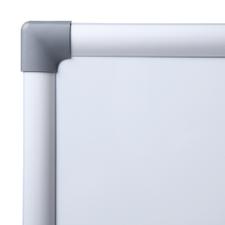How to Clean a Whiteboard
Maintaining a clean whiteboard is easy when done regularly. Each day, use a microfiber cloth to wipe down the surface using broad, rounded motions. This removes fresh ink particles before they have time to settle in and cause ghost marks. If anything remains, lightly dampen the cloth with water and wipe the whiteboard again. It’s best to avoid paper towels since they tend to be too abrasive for long-term use.
A weekly deep clean helps to preserve the integrity of your dry erase board. Use a few spritzes of whiteboard cleaner, or a 50/50 solution of isopropyl alcohol and water. This helps to break down ink residue that accumulates from frequent use, ensuring a consistently clear writing surface. Give the board a light spray, just enough to dampen, not saturate. Then wipe from top to bottom using a clean microfiber cloth. Finish with a dry pass to leave the board clean, streak-free, and ready for use.


How to Clean a Whiteboard
Maintaining a clean whiteboard is easy when done regularly. Each day, use a microfiber cloth to wipe down the surface using broad, rounded motions. This removes fresh ink particles before they have time to settle in and cause ghost marks. If anything remains, lightly dampen the cloth with water and wipe the whiteboard again. It’s best to avoid paper towels since they tend to be too abrasive for long-term use.
A weekly deep clean helps to preserve the integrity of your dry erase board. Use a few spritzes of whiteboard cleaner, or a 50/50 solution of isopropyl alcohol and water. This helps to break down ink residue that accumulates from frequent use, ensuring a consistently clear writing surface. Give the board a light spray, just enough to dampen, not saturate. Then wipe from top to bottom using a clean microfiber cloth. Finish with a dry pass to leave the board clean, streak-free, and ready for use.

Keeping Up Appearances
Even with regular upkeep, some ghosting or ink stains may persist. In those cases, just grab a microfiber cloth and some isopropyl alcohol and start gently rubbing the area in circles. For a more stubborn buildup, a dampened magic eraser is effective. Accidentally use a permanent marker? Just trace over it with a dry-erase marker and wipe it away while the ink’s still fresh. Prefer a natural route? A simple 1:1 mix of vinegar and water gets the job done, too.
Conduct a monthly inspection of the erase board’s perimeter, paying close attention to those edges and corners, where spots love to collect ink smudges. Use a cotton swab dipped in isopropyl alcohol to clean these areas thoroughly. If you’re using a melamine board, apply a small amount of whiteboard conditioner or even a dab of baby oil to keep the surface smooth. Other surfaces like porcelain and glass won’t need this step. While you’re at it, use this opportunity to give your erasers a quick rinse with warm soapy water, ensuring optimal performance.
One quick tip: Avoid using harsh chemicals like ammonia or bleach, as they can wear down your markerboard’s finish. Likewise, abrasive scrubbers can scratch protective coatings. Always use minimal moisture to prevent liquid from seeping behind the board and leading to long-term damage.
By following a consistent maintenance schedule— daily wiping, weekly cleanings, spot fixes, and a monthly check, you’ll extend the life of your dry erase board and ensure it remains a reliable, professional tool for any setting.
By following a consistent maintenance schedule— daily wiping, weekly cleanings, spot fixes, and a monthly check, you’ll extend the life of your dry erase board and ensure it remains a reliable, professional tool for any setting.
Shop Our Selection Of Whiteboards And Accessories
At VKF Renzel USA, we make white board use and maintenance easy with a full range of whiteboards and accessories, from our starter kit packed with essentials like spray cleaner, magnets, and markers to our budget-friendly Economy Series boards.


